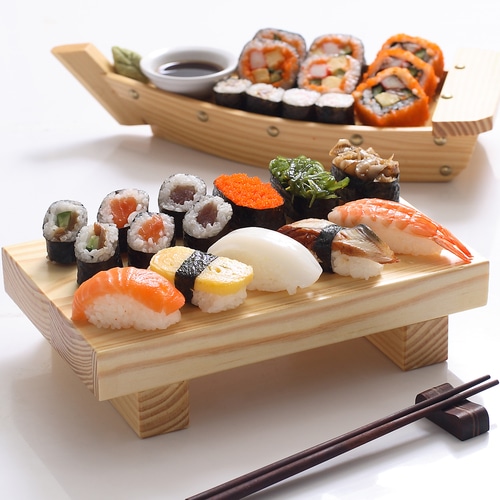
Moderation in everything
Your time at a sushi bar shouldn’t be about digging in and filling up. Instead, it should be about sampling the exotic cuisine by trying a little bit of everything. You can try a bite or two of pure, raw fish, a Maki roll, miso soup, vegetables and so on. The idea should be to get small bites of several different things. You’ll have the satisfaction of having had a lot without actually risking your diet.
Begin your meal with a healthy starter
Edamame (say eda-maa-may), the steamed and salted soybean-in-the-pod preparation that is an appetizer at most sushi bars, is a good way to start your meal off. To make your edamame even healthier, you can ask for a low-salt preparation when you place your order. Since sushi tends to be a high-sodium food, it’s a good idea to look for ways to cut down everywhere you can. Soy is a high-protein food. Eating a few edamame to begin can easily help you watch how much sushi you throw back.
A seaweed salad or a cup of miso soup can be excellent starters, too – they can fill you up with fiber. While these items tend to be high in salt too, they do help you take the edge off your appetite. With these starters, it’s a good idea to make sure that you get enough water to flush all the sodium out.
Make sure you order a pot of green tea
Hot green tea can be an excellent choice of beverage at a sushi bar. Not only does it give you healthy antioxidants, but it can also keep you away from one of those calorie-rich cocktails that they serve there. If an alcoholic beverage seems like a good idea, you should try sake or white wine. A glass will give you fewer than 50 calories, as opposed to the 500 present in the average syrupy cocktail.
Careful with the rice
Steamed rice can be so aromatic and light-looking that it can be tempting to fill up on it. White rice can be heavy on calories, though. Fortunately, most sushi bars these days do offer brown rice and quinoa. You aren’t likely to overeat with fiber-rich grains such as these. If you do wish to choose white rice, you should ask the chef to bring half as much as usual of each item.
Think twice about fried sushi
Many sushi items are fried – either by themselves or in a fat-rich batter. Fried items also tend to be served with calorie-heavy sauces. If you’re not sure which items are fried, you should watch out for words like crunchy and tempura. If you do pick one of these items, you need to make sure to go light on the other items that you order.
Watch the soy sauce
Every order at a sushi bar comes with soy sauce dip. While soy sauce is basically healthy, it’s important to dip into it in moderation – it tends to be sodium-rich. While sushi bars have been moving to low-sodium soy sauce, many continue with traditional sodium-rich recipes. The best sushi bars make their own soy sauce by mixing in water and kombu (an underwater vegetable harvested from the sea) to dilute the salt even further.
Sashimi is good for you
Sashimi or raw fish is among the healthiest items on the typical sushi bar. It’s protein packed, has very few calories and tastes good, too. It’s a good idea, though, to make sure that the sushi bar serves safe fish. Raw meat of any kind is risky. It can be a good idea to ask the sushi bar where they source their fish. Even if you don’t know anything about what the safest places are, the very fact that a sushi bar has a specific answer could mean that they think about their fish.
Finally, go easy with the spicy items
Sushi bar menus tend to have many items marked out as spicy. The spiciness usually comes from mayo sauce. If you want spicy sushi without the calorie cost of mayo, you should go with items that use wasabi and ginger, instead.
Related Articles By Cathe:

